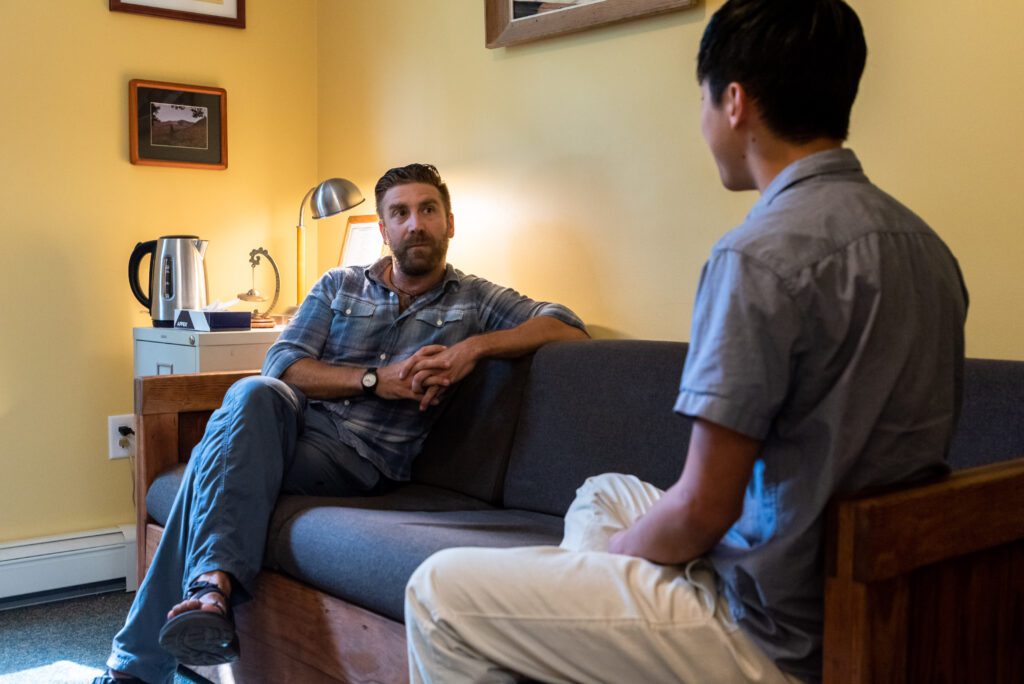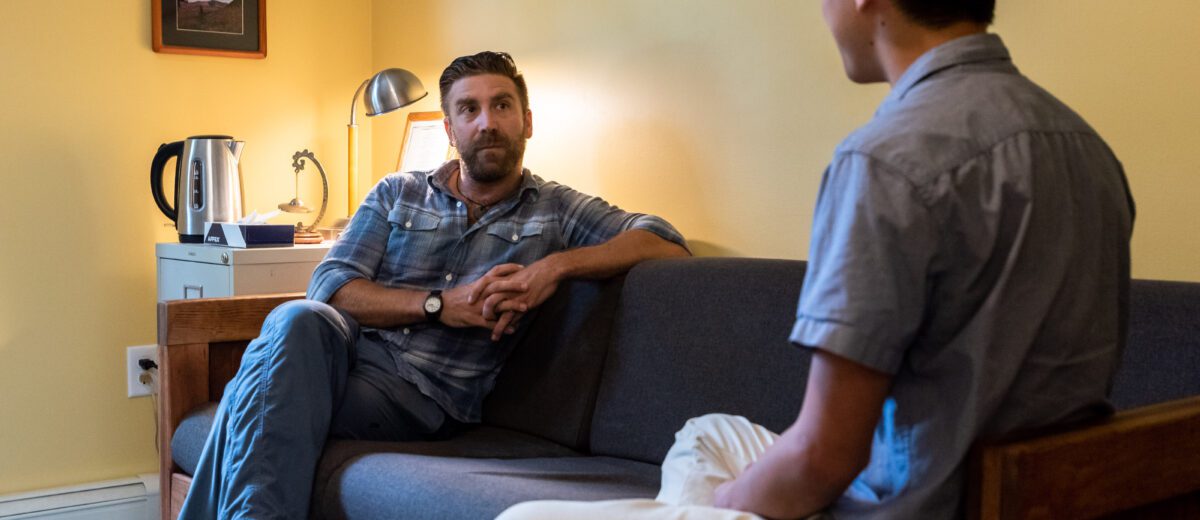Why I left Outpatient Therapy to be a therapist at a Residential Therapeutic Program.
By Mike Deluca, LCSW
I am writing to preface this post by saying I was an outpatient therapist for four years and I loved it! I also deeply respect my fellow outpatient therapists and their critical role in the continuum of care for clients. This post is intended to highlight some of the critical differences between these two levels of care, not to pit one against the other. Each has its important place in the continuum, but knowing the differences can help clients and families navigate the challenging treatment decisions that may arise.
I will be brief, but most of my career has been spent working with youth and families in one setting or another. I have been a clinical social worker for about nine years. I mention this to offer some background and context for my work as a clinician (outpatient and residential). I specialize in working with adolescents and their families. It is also worth noting that more services are often available to young people than to adults. This post isn’t meant to be an exhaustive list of all the services available on the continuum, as I am primarily trying to describe the two that I am most experienced with. However, I didn’t want to give the impression that only the two options exist.
When I finished graduate school and became a newly minted social worker, my first job was at a Community-based Mental Health Center (CMHC). It was incredible! It was an exciting time for me when I learned the ins/outs of being a professional social worker and clinician. CMHCs are basically organizations (usually not-for-profit) that serve their community’s diverse mental health needs. They serve a wide array of clients and mental health needs and employ an equally wide array of mental health professionals (mental health clinicians/therapists, case managers, nurses, psychiatrists, functional support specialists, etc.). The point of community-based mental health centers is to serve clients in their communities.
This is also the function of outpatient therapy in general. As outpatient therapists, we aim to treat the mental health needs of clients so that they may (at a minimum) remain engaged in their communities, families, jobs, schools, etc. I suspect that the overwhelming majority of clients that engage in mental health treatment do so in outpatient settings. Think meeting with my therapist once a week for an hour at their office (or via telehealth). It is a critical service and a difficult one.
When I was working as an outpatient therapist, I maintained a caseload of over 60 clients. (For contrast, my caseload at Summit Achievement maxes out at 6. Seriously.) That wasn’t uncommon among my colleagues at the CMHC. The demand for therapy was high, and my days were packed. I often couldn’t see all my clients weekly, so I continually needed to triage who needed to be seen and who could go bi-weekly (or even monthly in some cases). It was a demanding schedule to manage, and sometimes, I even needed to discharge clients off my caseload to make room for new admissions before they felt ready. I also spent a lot of time working with insurance companies or managing documentation.
I often wasn’t “allowed” to see a client for an individual session and have them participate in a family or group therapy session in the same week. Insurance often wouldn’t allow it. They wouldn’t even “allow” me to take a client on a walk or do an activity outside the office (which was frustrating when working with children). For comparison, I facilitate a one-hour Individual, Family, and Group therapy session weekly for clients in treatment at Summit Achievement. That is a lot of therapy in a short amount of time.
This may be the time to address the gorilla in the room. Insurance companies. That should really be its own topic, but I can’t discuss the differences in services between outpatient and residential care without at least mentioning their role. It is a complicated issue, but insurance providers have tremendous power over clients’ treatment. They are often one of the players who decide if a treatment level is warranted. That usually means the client’s mental health functioning needs to deteriorate to dangerous levels before residential care can be considered. I understand this logic, but it is often tricky for outpatient therapists and their clients.
Relatedly, there comes a time when you realize that your client’s mental health needs may exceed what you can offer within the frame of outpatient therapy. Maybe their functioning has deteriorated, so they no longer attend work or school. Perhaps they cannot keep themselves safe, or their substance use has increased to dangerous levels. Maybe they are so depressed or anxious they refuse to leave their house, attend school, or even attend therapy. There could be many scenarios that could arise. For many therapists, this can be a challenging dynamic to address. It isn’t easy to acknowledge when a client’s needs might be beyond our care. To make matters even more complicated, clients often have limited options, and the existing options are, by design, intensive. They can also be quite expensive.
Sometimes, clients decompensate to the point where they need to be placed (voluntarily or involuntarily) in a “higher level of care.” Initially, this is often a psychiatric hospitalization where the primary treatment objective is stabilization and return to their community. If available, they may be discharged to a Partial Hospitalization Program (PHP), where they spend several hours a day in structured therapeutic activities and groups but spend the night at home. Similarly, in recent years Intensive Outpatient Programs (IOP) have become more common.
These critical services may stabilize clients and offer them enough support/skills to return home and remain there. They often allow clients to participate in therapy several times weekly (individual, family, group) by participating in programming for several hours a day but still being able to return home at night. But this doesn’t always work for everyone, and occasionally a client may experience a “revolving door” scenario where they oscillate between hospitalization to outpatient and back to hospitalization. This is frustrating for both clients and clinicians alike.
For young people (including young adults), this is where residential treatment can be a necessary intervention in the continuum.
So, what is residential care, and how does the therapist’s role differ from outpatient? The most obvious difference is that clients reside in the treatment milieu. This offers a constellation of different benefits that support the client’s treatment goals. For instance, when a client is admitted to a residential setting, there is often more structure, consistency, and routine (ex: wake-up, bedtime, regular meals, healthier meals, medication compliance, daily exercise, etc.). We can observe if these things are occurring or not. These factors play a significant role in assessing a client’s functioning, needs, and progress. They are also some of the important functions of restabilizing.
The medication piece is a big one. In a residential setting, I can confidently know that students are taking their medications as prescribed (or if they aren’t). This is an essential factor in determining if the medication is, in fact, working as intended. As an outpatient therapist, I have numerous examples of clients (especially teenagers) being unreliable reporters about consistently taking their medications (or eating meals, sleeping, showering, etc.). Sometimes even parents aren’t fully aware if the medications are being taken regularly or not. I can also assess and treat a client during a period of time when they are sober. Having a client actively using substances can muddy the water and affect treatment progress. Residential care is intended to address this issue as well.
Another critical factor is social engagement. Many of the mental health issues facing young people (depression, anxiety, ADHD, substance use, social skills, etc.) often connect back in one way or another to social engagement. In residential treatment, we can create intentional and supportive therapeutic spaces for young people to work through these issues. This is often difficult to manage in an outpatient setting when students struggle with social anxiety, avoidance, low self-esteem, poor social skills, etc. They need momentum and skill mastery before they are ready to take on these challenges back home. Residential settings can more effectively foster that change for those vulnerable clients who need it.
As an outpatient therapist, I tried hard to offer my clients (and their families) “homework” or weekly assignments. They were basically goals, challenges, or skills for clients to work on outside of the therapy appointment. I knew then (as I know now) that real change for clients happens not in the one-hour session with me each week but all the other hours outside of my appointment. This means restoring some of the responsibility back to the client for their treatment goals and recovery. Getting clients to reliably do the work outside of the therapy appointment was often challenging, and client progress was often slower because of it.
This is the most important part for me. A significant aspect of treatment for my clients is the work I encourage them to do when they are not meeting with me. My one-hour session is still impactful. I still need to work hard to build rapport and assess a client’s clinical needs. We still need to establish goals, provide treatment, and assess progress. The difference is I can write up exercises, skills, or activities that I think would benefit the client and have far more confidence that the client will do the work.
As an outpatient therapist, do you know how many times I have asked clients to practice breathing exercises at home to manage anxiety or stress, only to find out they never even tried or “forgot?” Countless. In a residential setting, there can be more accountability for clients following through with their treatment and it creates an environment where clients need to take more ownership of their progress and recovery. When this occurs, clients begin to develop more confidence in the skills and concepts of treatment, and they become gradually more intrinsically motivated to do the work. They become the captains of their own ship, not just a participant. If I am honest, this is the primary reason why I love working as a residential therapist.
I often tell my clients that my goal is to work myself out of a job as fast as possible. I won’t take any shortcuts and I will certainly hold clients accountable for their responsibilities, but I am trying to get clients home! I want to give them all the mental health tools, hacks, and pro tips I can to support them in returning to their families, friends, schools, and communities. I want them to return with the tools not just to stay there, but thrive there!
An important factor in determining the chances of a client’s success returning home is whether or not they have a talented outpatient therapist waiting for them when they get there.
Clients need their outpatient therapist to help them integrate these new skills they have learned. The role is critical, and I have tremendous respect for their work. I can’t imagine my work as a therapist at Summit Achievement without them. The partnership is an essential part of the continuum of care. I know where my passion is on that continuum.

